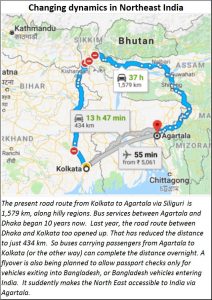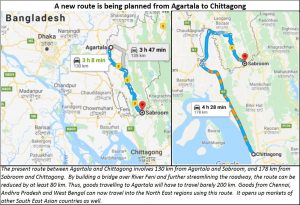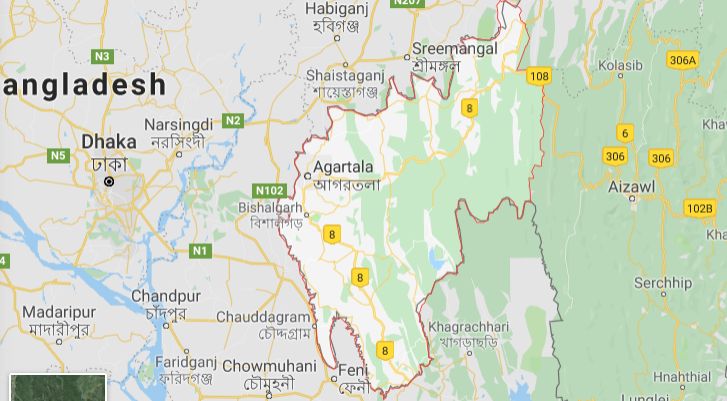https://www.freepressjournal.in/analysis/tripura-could-become-the-economic-powerhouse/1465094
Tripura could become the economic powerhouse for NE India
RN Bhaskar – 21 Feb 2019
Ten years ago, nobody could have imagined economically backward Tripura to become the business hub for the entre North East India. But geography, defence imperatives and political developments have propelled infrastructure development in such a way that it could actually alter all equations in this region.
 Take for instance the conventional routes from Kolkata to Agartala, state capital for Tripura. For almost 55 years, people had to take the road through Siliguri, going through what defence experts call the Chicken’s Neck. That is the narrow strip near which the Doklam crisis took place.
Take for instance the conventional routes from Kolkata to Agartala, state capital for Tripura. For almost 55 years, people had to take the road through Siliguri, going through what defence experts call the Chicken’s Neck. That is the narrow strip near which the Doklam crisis took place.
Then in 1999, the government agreed to open the road route between Kolkata and Dhaka. In 2001, both countries agreed to extend the road connectivity further by allowing buses to travel from Dhaka to Agartala. Thus, all of a sudden, for passengers opting to travel by bus, the road journey collapsed from 1,579 km to just 434 km. Commercial traffic along this route has still not taken off – on account of customs and other procedural issues. But the possibility of commercial traffic plying this route is no longer a dream.
Talks are underway to build an elevated expressway spanning the distance between the two cities. If and when that takes off, Indians will be able to travel without having to deal with passport controls. Only those seeking to take the exit to Bangladesh would be subject to immigration and customs checks. These roads will integrate NE India into mainstream India. Discussions are also ongoing to extend the existing railway links between Kolkata and Dhaka to reach Agartala.
 But there is another development that could alter all equations for the NE India region. Biplab Kumar Deb, chief minister of Tripura has already embarked on two more developmental projects that could change trading routes in the region forever.
But there is another development that could alter all equations for the NE India region. Biplab Kumar Deb, chief minister of Tripura has already embarked on two more developmental projects that could change trading routes in the region forever.
The first is a bridge over the Feni River near Sabroom. That bridge – expected to be completed by December 2019 — is to lead to a new road headed to Chittagong, which could shorten the existing 300 km winding road between Agartala and Chittagong. The new road from the Feni bridge will be a straight wide one which will connect the port city of Chittagong to Agartala. Expect a great deal of cargo movement to the NE region to take up this route. Thus goods from Kolkata, Andhra Pradesh and Tamil Nadu will now take the sea route to Chittagong, from where they have direct access to Agartala, and to other regions in NED India.
At the same time, the chief minister is also building a jetty at at Sonambra, That will allow small ships (each capable of carrying load equivalent to that of 50 trucks) to travel from Chittagong to Sonambra and then up the Mahanadi River into the (North Eastern) Gomti River.
This has two advantages.
First, the entire North East is a riverine area. There are rivers and tributaries almost everywhere. Waterways connect more villages and towns than do roads and rail. Each village is a consumption centre, and possibly might emerge as export hubs for vegetables, fruit and even milk, meat and leather over the next couple of decades. Thus promoting the river routes will help this region much more than roads and rail.
Second, as is well known, river transport will invariably be cheaper than road or rail transport (http://www.asiaconverge.com/2016/11/india-waterways-a-gamechangerrobust-water-transportation-can-help-india-drastically-cut-freight-costs/). Expect the development of waterways to actually make villages and towns along river banks that much more robust trading partners with Agartala and Chittagong.
There is a third major advantage. The army is delighted that it now has a second route to reach out to the entire North East without depending overmuch on the narrow Chicken’s Neck.
The road and rail links between Kolkata and Dhaka will gradually get dwarfed by waterways connected to Chittagong port. Since Tripura is a landlocked state – access to a sea port like Chittagong will allow it to integrate more easily with the entire South East region.
Today, almost everything Tripura needs for daily consumption is imported – (non-sticky, often basmati) rice, vegetables, fruit, even milk. Much of this comes via Siliguri which pushes up transportation costs. The new linkages will help reduce costs significantly.
But this is not all. Tripura’s chief minister has very aggressive plans for promoting travel and tourism. Tripura boasts of some of the most picturesque travel and holiday resorts. And it has religious sites that should make spiritual tourism very attractive. But travel and tourism become difficult if travel linkages aren’t there. Water transport will create this connectivity, and also reduce costs.
In addition to all this the government now wants Tripura to focus on exports as well. But that is another story.



































COMMENTS